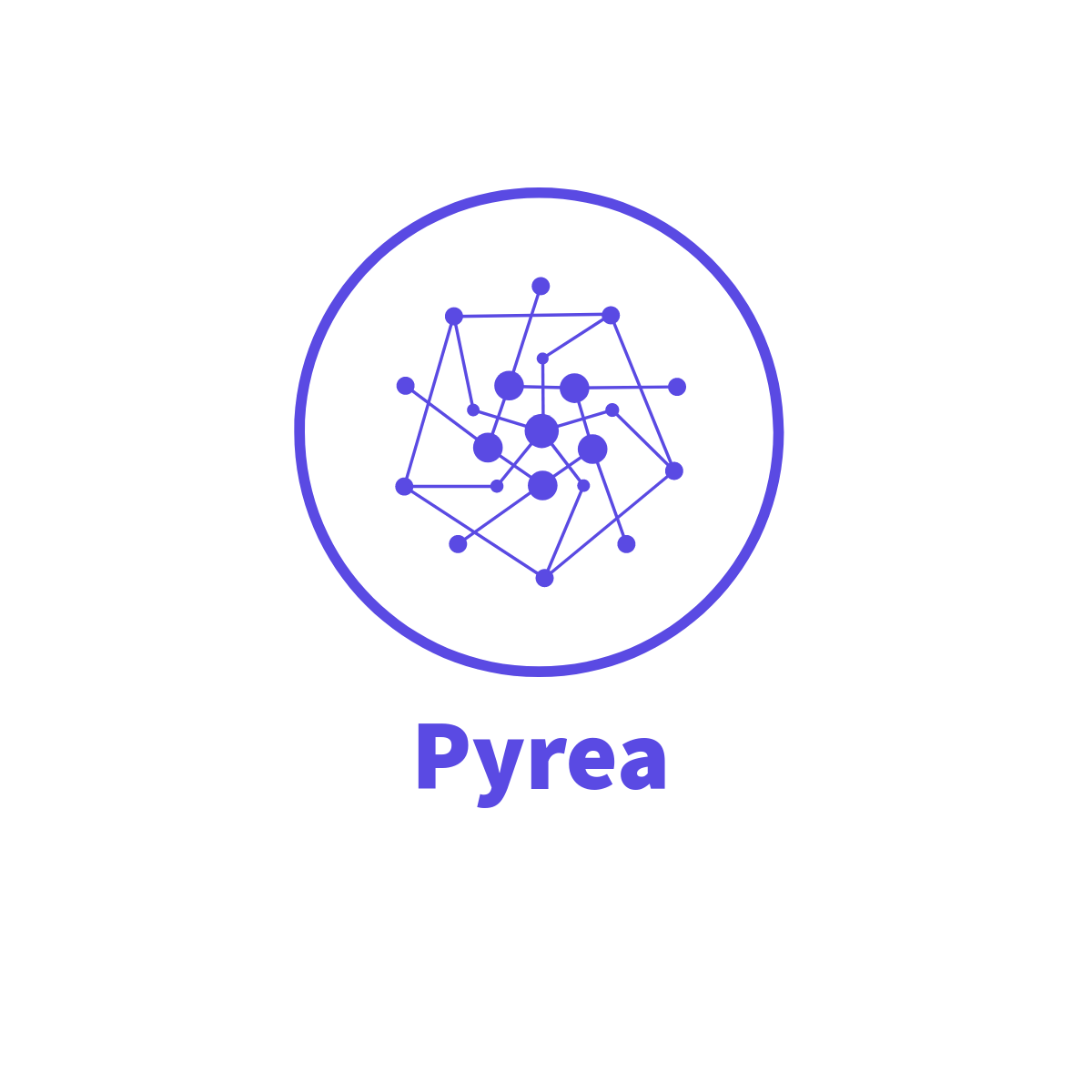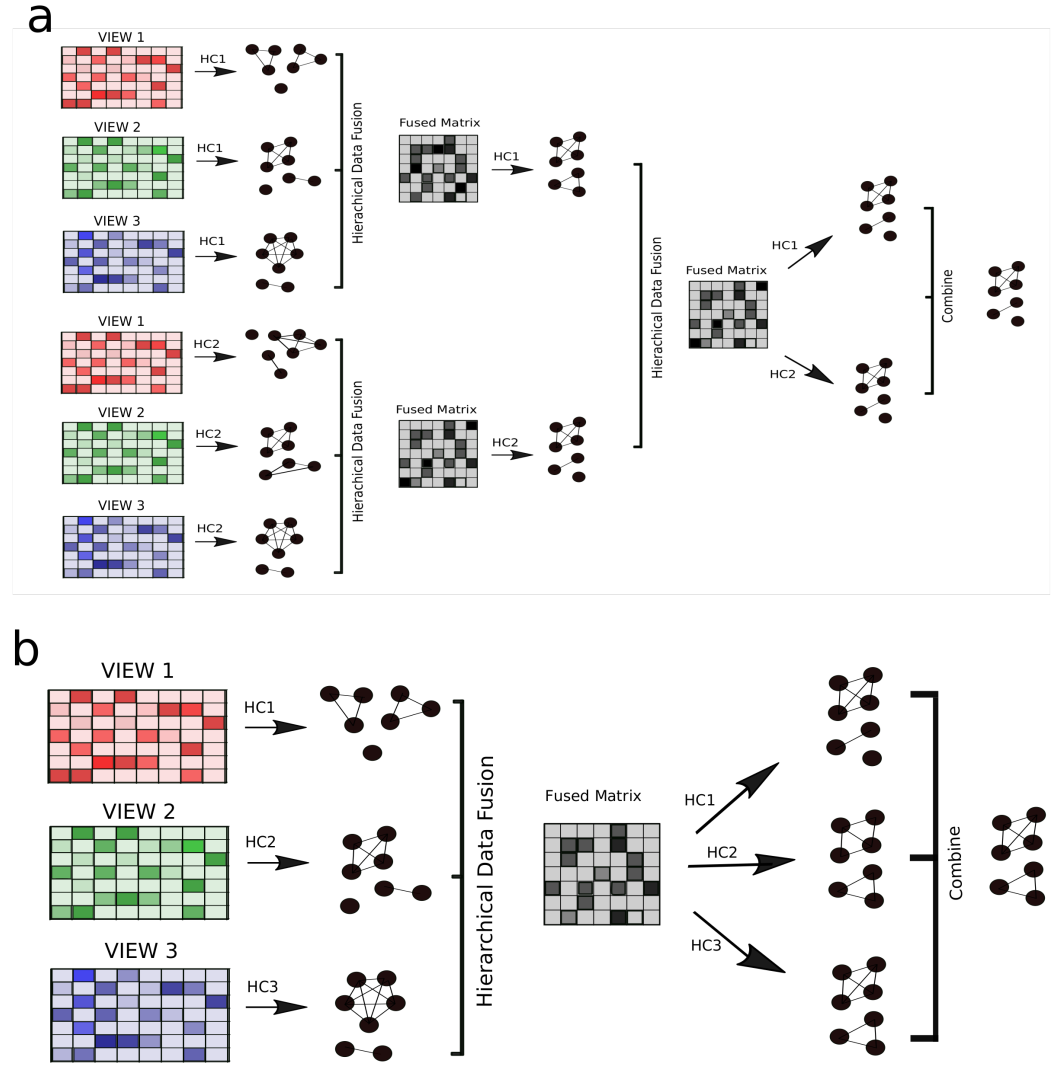Multi-view clustering with deep ensemble structures.
Project description
Pyrea

Multi-view clustering with flexible ensemble structures.
The name Pyrea is derived from the Greek word Parea, meaning a group of friends who gather to share experiences, values, and ideas.


Installation
Install Pyrea using pip:
pip install pyrea
This will install the latest version of Pyrea from PyPI.
Usage
The Pyrea software package is the accompanying software for our paper: Parea: multi-view ensemble clustering for cancer subtype discovery[^1].
While Pyrea allows for flexible and custom architectures to be built, two structures are discussed specifically in the paper cited above, namely Parea 1 and Parea 2.
Both the structures, which are described in detail below as well as in the paper mentioned above, can be quickly generated and applied to your data using two helper functions, parea_1() and parea_2(), and can be quickly run as follows
import pyrea
import numpy as np
# Create sample data:
d1 = np.random.rand(100,10)
d2 = np.random.rand(100,10)
d3 = np.random.rand(100,10)
data = [d1,d2, d3]
labels = pyrea.parea_2(data)
which executes Parea 2.
Default parameters are used which match those used in our experiments discussed in the paper above. These default parameters can of course be overridden. As there are many combinations of parameters that could be used, a genetic algorithm can be utilised to find the optimum parameters, as shown in the next section.
Genetic Algorithm
The Parea 1 and Parea 2 structures can be optimised using a genetic algorithm in order to find the best combinations of clustering methods, fusion methods, and number of clusters.
For example, to find optimal parameters for Parea 2:
import numpy as np
import pyrea
from sklearn import datasets
d1 = datasets.load_iris().data
d2 = datasets.load_iris().data
d3 = datasets.load_iris().data
data = [d1,d2,d3]
params = pyrea.parea_2_genetic(data, max_k=5)
where max_k refers to the maximum number of clusters to attempt for each layer.
Note that params contains the optimal parameters found by the genetic algorithm. To get the labels, run parea_2() using these parameters and your data:
pyrea.parea_2(data, *params)
which will return the cluster labels for your data.
Note: Currently the genetic algorithm uses a population size of 100 and runs for 10 generations. This function will be updated to allow these to be customised.
API
Please note that Pyrea is work in progress. The API may change from version to version in the coming weeks, which could introduce breaking changes.
In Pyrea, your data are organised in to views. A view consists of the data in the form of a 2D matrix, and an associated clustering algorithm (a clusterer).
To create a view you must have some data, and a clusterer:
import pyrea
# Create your data, which must be a 2-dimensional array/matrix.
d = [[1,2,3],
[4,5,6],
[7,8,9]]
# Create a clusterer
c = pyrea.clusterer("hierarchical", n_clusters=2, method='ward')
v = pyrea.view(d, c)
You now have a view v, containing the data d using the clustering algorithm
c. Note that many views can share the same clusterer, or each view may have a
unique clusterer.
To obtain the cluster solution the specified view can be executed
v.execute()
The clustering algorithm can be either 'spectral', 'hierarchical', 'dbscan', or 'optics'. See the documentation for a complete list of parameters that can be passed when creating a clusterer.
As this is a library for multi-view ensemble learning, you will normally have multiple views.
A fusion algorithm is therefore used to fuse the clusterings created from multiple views. Therefore, our next step is to create a fuser object:
f = pyrea.fuser('disagreement')
With you fusion algorithm f, you can execute an ensemble. The ensemble is created with a set of views and a fusion algorithm,
and its returned object (distance or affinity matrix) can again be specified as a view:
# Create a new clusterer with precomputed=True
c_pre = pyrea.clusterer("hierarchical", n_clusters=2, method='ward', precomputed=True)
v_res = pyrea.view(pyrea.execute_ensemble([v1, v2, v3], f), c_pre)
This newly created view, v_res can subsequently be fed into another ensemble,
allowing you to create stacked ensemble architectures, with high flexibility.
A full example is shown below, using random data:
import pyrea
import numpy as np
# Create two datasets with random values of 1000 samples and 100 features per sample.
d1 = np.random.rand(1000,100)
d2 = np.random.rand(1000,100)
# Define the clustering algorithm(s) you want to use. In this case we used the same
# algorithm for both views. By default n_clusters=2.
c = pyrea.clusterer('hierarchical', n_clusters=2, method='ward')
# Create the views using the data and the same clusterer
v1 = pyrea.view(d1, c)
v2 = pyrea.view(d2, c)
# Create a fusion object
f = pyrea.fuser('disagreement')
# Specify a clustering algorithm (precomputed = True)
c_pre = pyrea.clusterer("hierarchical", n_clusters=2, method='ward', precomputed=True)
# Execute an ensemble based on your views and a fusion algorithm
v_res = pyrea.view(pyrea.execute_ensemble([v1, v2], f), c_pre)
# The cluster solution can be obtained as follows
v_res.execute()
Ensemble Structures
Complex structures can be built using Pyrea.
For example, examine the two structures below:
We will demonstrate how to create deep and flexible ensemble structures using the examples a) and b) from the image above.
Example A
This ensemble consists of two sets of three views, which are clustered, fused, and then once again combined in a second layer.
We create two ensembles, which represent the first layer of structure a) in the image above:
import pyrea
import numpy as np
# Clusterers:
hc1 = pyrea.clusterer('hierarchical', method='ward', n_clusters=2)
hc2 = pyrea.clusterer('hierarchical', method='complete', n_clusters=2)
# Fusion algorithm:
f = pyrea.fuser('disagreement')
# Create three random datasets
d1 = np.random.rand(100,10)
d2 = np.random.rand(100,10)
d3 = np.random.rand(100,10)
# Views for ensemble 1
v1 = pyrea.view(d1, hc1)
v2 = pyrea.view(d2, hc1)
v3 = pyrea.view(d3, hc1)
# Execute ensemble 1 and retrieve a new view, which is used later.
hc1_pre = pyrea.clusterer('hierarchical', method='ward', n_clusters=2, precomputed=True)
v_ensemble_1 = pyrea.view(pyrea.execute_ensemble([v1, v2, v3], f), hc1_pre)
# Views for ensemble 2
v4 = pyrea.view(d1, hc2)
v5 = pyrea.view(d2, hc2)
v6 = pyrea.view(d3, hc2)
# Execute our second ensemble, and retreive a new view:
hc2_pre = pyrea.clusterer('hierarchical', method='complete', n_clusters=2, precomputed=True)
v_ensemble_2 = pyrea.view(pyrea.execute_ensemble([v4, v5, v6], f), hc2_pre)
# Now we can execute a further ensemble, using the views generated from the
# two previous ensemble methods:
d_fuse = pyrea.execute_ensemble([v_ensemble_1, v_ensemble_2], f)
# The returned distance matrix is now used as an input for the two clustering methods (hc1 and hc2)
v1_fuse = pyrea.view(d_fuse, hc1_pre)
v2_fuse = pyrea.view(d_fuse, hc2_pre)
# and the cluster solutions are combined
pyrea.consensus([v1_fuse.execute(), v2_fuse.execute()])
Helper Function
See the parea_1() helper function for a pre-built version of structure above.
Example B
As for structure b) in the image above, this can implemented as follows:
import pyrea
import numpy as np
# Clustering algorithms
c1 = pyrea.clusterer('hierarchical', method='ward', n_clusters=2)
c2 = pyrea.clusterer('hierarchical', method='complete', n_clusters=2)
c3 = pyrea.clusterer('hierarchical', method='single', n_clusters=2)
# Clustering algorithms (so it works with a precomputed distance matrix)
c1_pre = pyrea.clusterer('hierarchical', method='ward', n_clusters=2, precomputed=True)
c2_pre = pyrea.clusterer('hierarchical', method='complete', n_clusters=2, precomputed=True)
c3_pre = pyrea.clusterer('hierarchical', method='single', n_clusters=2, precomputed=True)
# Fusion algorithm
f = pyrea.fuser('disagreement')
# Create the views with the random data directly:
v1 = pyrea.view(np.random.rand(100,10), c1)
v2 = pyrea.view(np.random.rand(100,10), c2)
v3 = pyrea.view(np.random.rand(100,10), c3)
# Create the ensemble and define new views based on the returned disagreement matrix v_res
v_res = pyrea.execute_ensemble([v1, v2, v3], f)
v1_res = pyrea.view(v_res, c1_pre)
v2_res = pyrea.view(v_res, c2_pre)
v3_res = pyrea.view(v_res, c3_pre)
# Get the final cluster solution
pyrea.consensus([v1_res.execute(), v2_res.execute(), v3_res.execute()])
Helper Function
See the parea_2() helper function for a pre-built version of structure above.
Extensible
Pyrea has been designed to be extensible. It allows you to use Pyrea's data fusion techniques with custom clustering algorithms that can be loaded in to Pyrea at run-time.
By providing a View with a ClusterMethod object, it makes providing custom clustering algorithms uncomplicated. See Extending Pyrea for details.
Work In Progress and Future Work
Several features are currently work in progress, future updates will include the features described in the sections below.
HCfused Clustering Algorithm
A novel fusion technique, developed by one of the authors of this software package, named HCfused, will be included soon in a future update.
General Genetic Optimisation
The package will be extended to allow for any custom Pyrea structures to be optimised using a genetic algorithm.
Compilation of HC Fused C++ Code
To use the HC Fused method you may need to compile the source code yourself if binaries are not available for your operating system. HC Fused has been implemented in C++, see the HC_fused_cpp_opt6.cpp source file for more details.
Pre-compiled binaries are available for Linux and have been tested using Linux only. The instructions below pertain to Linux only. For Windows please consult https://docs.python.org/3.5/library/ctypes.html#loading-shared-libraries and use a compiler such as MSVC or MinGW.
To compile HC Fused (and then create a shared library/dynamic library) execute the following on the command line:
$ clang++ -c -fPIC HC_fused_cpp_opt6.cpp -o HC_fused_cpp_opt6.o
and then create the .so file shared library file:
$ clang++ HC_fused_cpp_opt6.o -shared -o libhcfused.so
and finally place the libhcfused.so file in the root directory of the package's installation directory.
Miscellaneous
Logo made by Adobe Express Logo Maker: https://www.adobe.com/express/create/logo
[^1]: Pfeifer, B., Bloice, M.D., & Schimek, M.G. (2022). Parea: multi-view ensemble clustering for cancer subtype discovery. arXiv. https://arxiv.org/abs/2209.15399
Project details
Release history Release notifications | RSS feed
Download files
Download the file for your platform. If you're not sure which to choose, learn more about installing packages.













